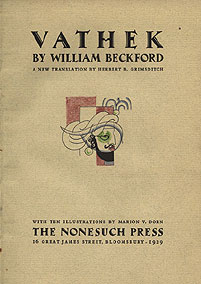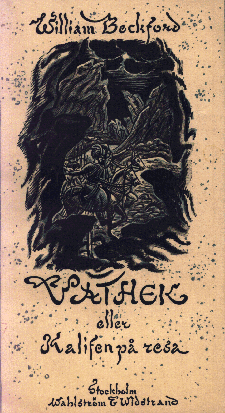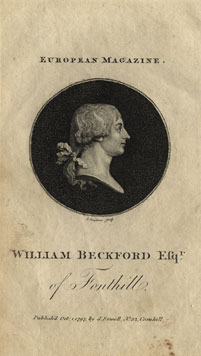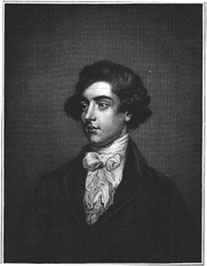A FEW NOTES ON COLLECTING BECKFORDIANA
Dick Claésson
I sometimes receive letters or e-mails requesting an evaluation of items of Beckfordian interest. Usually these queries are quite easy to answer, in a sweeping sort of way. What, for example, is the monetary value of a particular edition of Vathek? What is the going rate for a decent and complete large-paper copy of Rutter’s Delineations of Fonthill Abbey? Does a dedication in Beckford’s own writing add to the value of a first edition?
Monetary values are only a transient and shallow measure of any individual’s life and works. Yet it is perfectly clear that Beckfordiana has, in recent years, experienced something of an economic boom, no doubt reflecting the increasing interest in his person. The following few words are intended as a quick guide to the collecting of Beckfordiana.
VATHEK EDITIONS
Five years ago, if one was lucky enough, it was quite possible to find a first edition of the 1786 London Vathek for less than $500. Today, a good copy will fetch considerably more in the antiquarian bookshops, going for anything between $750 and $1,500. That is a considerable increase, although, of course, the odd cheaper copy may still appear and auction prices, as almost always, may go considerably lower. In fact, almost all contemporary editions of Vathek - that is any edition prior to 1844 - are expensive today. None of the editions prior to 1823 are cheap, by any measure: even the fourth edition, printed in 1823, will fetch something like $200-450. Vathek editions are, in fact, a good indication of the current interest in Beckford from a collector’s viewpoint. While I personally did not consciously pursue it as a collection, I suddenly realised - a few years back - that I had amassed some twenty or thirty different editions of Vathek. From there on it has simply been a question of adding to the collection any item which is affordable. Today, I have more than sixty different editions of Vathek fighting for shelfspace at home. Collecting editions of Vathek is addictive, so beware. There are many Vatheks floating around out there, and a few times every year a ”new”, hitherto unbibliographised edition surfaces. Late 19th century American editions, for instance, are plentiful and often quite cheap. A good way to start out as a budding collector of Beckfordiana!
The cheapest, ”vintage” Vatheks go for around $5-10 (I do not mean the ones currently in print; these are always cheap). You can be lucky and find an early 20th century edition for as little as $5, but some - often quite unassuming - editions fetch much higher prices. Watch out for the 1868 London Vathek, for instance, worth as much as $60-80; or the 1912 Episodes of Vathek, of which a good copy is worth in excess of $100; or the 1928 Vathek illustrated by Mahlon Blaine, fetching anything from $50 (which is very cheap) up to $200; or the Nonesuch Vathek, 1929, illustrated by Marion V. Dorn - easily worth the $100-$200 dollars which it usually sells for. Condition isn’t everything here, though the more recent volumes may of course be had for less money provided you find a poor copy. You would find it difficult to find a very good copy of the 1868 London Vathek, however, so this edition, in fair condition, still fetches a tidy sum.
FIRST EDITIONS OF BECKFORD’S WORKS
Beckford first editions, besides Vatheks, are also hard to come by and quite expensive. His debut book, Biographical Memoirs of Extraordinary Painters (1780), which exists in two editions printed in 1780 differing only on the titlepage, fetches from $400 up to considerably higher sums of money depending on the condition. I have seen a spectacular copy, signed by Beckford (signed copies are exceptionally rare to find in themselves) to Lord Nelson’s chaplain, which, though not for sale, is certainly an object worth several thousand dollars (even an insignificant cheque signed by Beckford goes for something like $300 so a signed first edition is, of course, much more valuable). Dreams, Waking Thoughts and Incidents (1783), to my knowledge, does not exist outside the larger research libraries. I would not wish to begin to speculate on a value for any of the handful of copies which survive, but it is surely one of the most significant pre-romantic texts and certainly one of the scarcest. Scarce, though not as impossible, are also Azemia (1797) and Modern Novel Writing (1796), none of which I have ever seen for sale; I would not pass on the opportunity to buy any of them for a measly $500 - they would probably fetch considerably more than this. Epitaphs (1825), which the Book Collector in 1998 valued at £200-300, is so scarce as to merit mentions in library journals whenever a library is lucky enough to find a copy for sale - surely an item in the thousand of dollars-range, though I myself have never seen one for sale.
The later travel works are less difficult to find. Recollections of an Excursion to the Monasteries of Alcobaça and Batalha (1835) is not too difficult to find for $300 or more; Italy, with Sketches of Spain and Portugal (1834), in two volumes, fetches somewhat more - be prepared to pay at least $350 for a copy in decent condition.
FONTHILL ABBEY GUIDEBOOKS
Fonthill guidebooks are, besides Beckford’s works in first editions, perhaps the most expensive of all books Beckfordian. There is no contemporary guidebook of Fonthill Abbey - i.e. from the early 19th century - that is easily affordable, and as they contain a wide array of engravings they have often been cannibalised for decorative purposes. Complete guidebooks are today increasingly difficult to come by. The most desirable remains John Rutter’s Delineations of Fonthill Abbey (1823). Today, a large paper copy in good condition, with all plates present, will set you back somewhere between $500 and $2,000, depending on your luck on the day and the overall condition of the copy. John Britton’s competing guidebook, Graphical and Literary Illustrations of Fonthill (1823) is somewhat more affordable, but only marginally so.
The smaller guidebooks are perhaps less costly, but none (unless you are very lucky and/or they’re incomplete or in very poor condition) dip beneath the $100 mark.
ENGRAVINGS
Engravings abound, and most of these are culled from the Fonthill Abbey guidebooks. For a good engraving of the Abbey, don’t expect to pay much more than $30-50 (if it’s in good condition), and, if it’s a small one and not one of the most desired views, perhaps even less. Unless you are very sure of what you’re buying, be sure to check out Jon Millington’s formidable checklist of Fonthill engravings.
PORTRAITS
There are not that many engraved portraits of Beckford around. There is a good one from the European Magazine (1797), and if you’re fortunate enough to find it, it will set you back perhaps $40-60. Another portrait engraving, after Reynolds, culled from the first edition of Italy; with Sketches of Spain and Portugal (1834), is much more common: don’t pay more than $20-40.
AUCTION CATALOGUES
The contemporary, 19th century auction catalogues are scarce to say the least. The most desirable one, from the sale of Fonthill in 1823, is a massive work and the scope of the catalogue is reflected in its value. To buy this, you will need deep pockets: if you’re lucky to find it, even in fair condition, don’t expect to get away with less than $500, and don’t be surprised to see prices far above this level. The earlier auction catalogues are also scarce as well as expensive and probably fall into the same general price range (I must confess I have never seen one of these for sale).Of course, there is a budget alternative: simply shop around for Robert J. Gemmett’s immensely useful facsimile edition of all of the auction catalogues up to and including the 1823 sale. This book will set you back a mere $40-50, which is money well spent if you are intending to do some serious research.
The most useful auction catalogue is perhaps the 1882 catalogue, detailing Beckford’s library in four volumes. For a complete set, including the list of buyers and the prices realised, expect to part with in excess of $400 (and that is a conservative estimate for a working copy). This catalogue is not available in any reprints and is increasingly difficult to find. Do not confuse it with the other auction catalogues from the same period: what you want is the one detailing Beckford’s library.
CRITICISM
Yes: even books about Beckford can be expensive, although most are affordable enough. Of the standard biographies, only a handful have achieved the status of a collectible. Cyrus Redding’s 1859 biography, Memoirs of William Beckford of Fonthill, in two volumes, is a rarity today and is worth in excess of $200. Lewis Melville’s beautiful 1910 volume, The Life and Letters of William Beckford, is becoming more expensive for each year, though if you’re lucky, you can find a copy for as little as $40-60 (don’t be fooled by Japanese antiquarian prices as these are absurdly high; I have seen a copy of Melville for sale in Japan for somewhere in the region of $500). J. W. Oliver’s The Life of William Beckford (1932) is one of the most desirable biographies; in good condition and with a dustjacket, this will cost you approximately $100-150 dollars. Without the dustjacket you should not pass on the opportunity to buy a good clean copy at $40-50. André Parreaux’s massive dissertation in French (1960), William Beckford, clocks in at perhaps $40-60 and is not easy to find.
James Lees-Milne’s 1976 folio (the U.K. edition), William Beckford, is also an expensive item, going for as much as $100-150 in very good condition with the dustjacket. The U.S. edition is considerably cheaper but is still preferable to the later, paperback editions. Another difficult item to come by is Robert J. Gemmett’s 1977 monograph in the Twayne Author Series, William Beckford. Issued without a dustjacket, this unassuming volume will cost you in excess of $50, provided it is not an ex-library copy.
None of the other biographies reach these prices. Most often you can find a copy of any of the other for perhaps $20-40.
So how does one find these rare items of Beckfordiana? Well, there are a few channels through which, it seems, almost all of them travel at one time or another. Be sure to check the antiquarian booksellers online, preferably at a meta-search engine (I would recommend http://www.bookfinder.com as this is the fastest and largest search engine devoted to antiquarian books). Also, do look in on eBay occasionally, as these online auctions are a sure way of finding bargains.
[This page was updated on February 13, 2002]

Titlepage of the 1929 Nonesuch Vathek.

Front cover of the only Swedish edition of Vathek (1927).

Beckford; the European Magazine engraving (1797).

Beckford; the Recollections (1835) engraving.